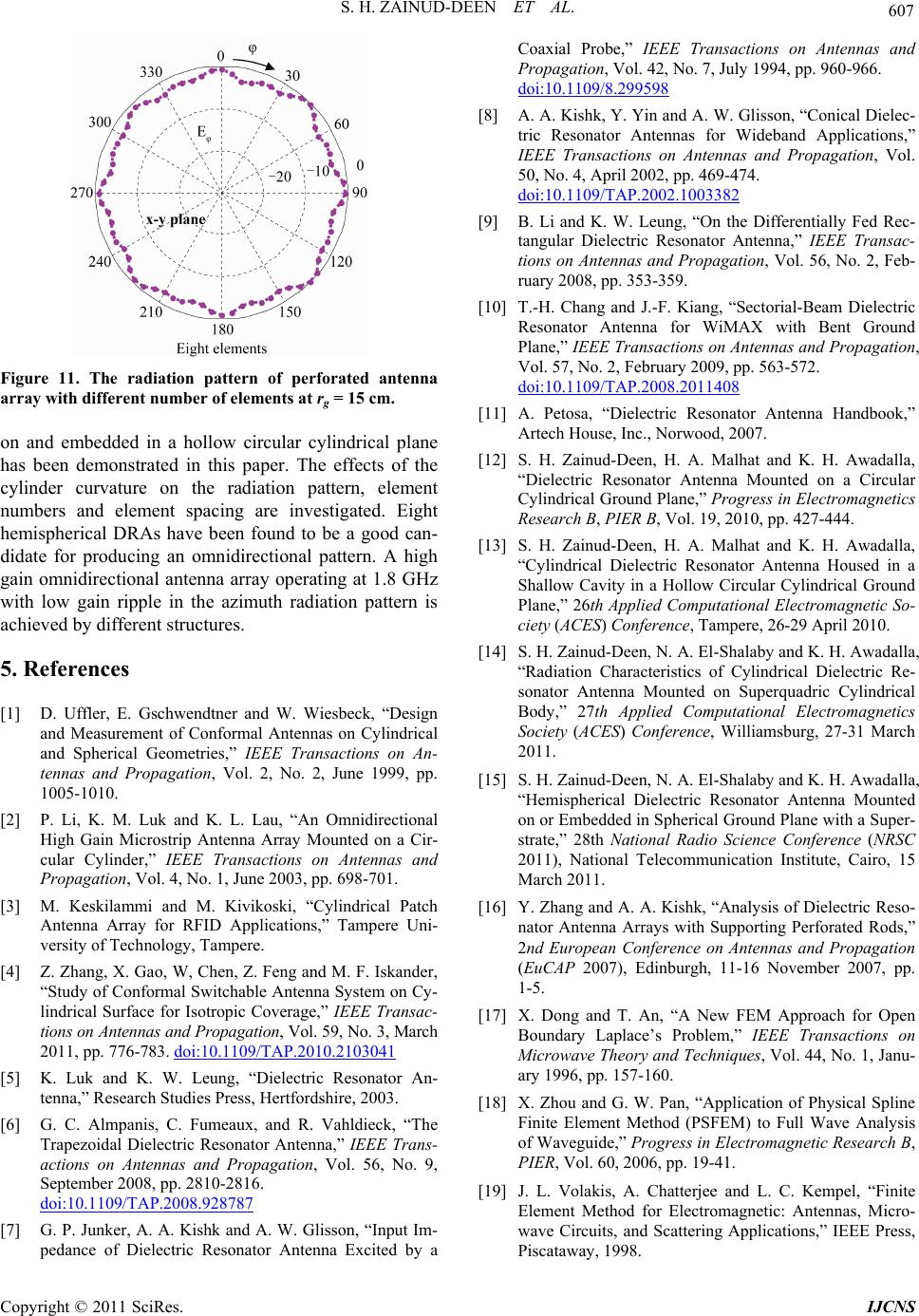
S. H. ZAINUD-DEEN ET AL.
607
Figure 11. The radiation pattern of perforated antenna
array with different number of elements at rg = 15 cm.
on and embedded in a hollow circular cylindrical plane
has been demonstrated in this paper. The effects of the
cylinder curvature on the radiation pattern, element
numbers and element spacing are investigated. Eight
hemispherical DRAs have been found to be a good can-
didate for producing an omnidirectional pattern. A high
gain omnidirectional antenna array operating at 1.8 GHz
with low gain ripple in the azimuth radiation pattern is
achieved by different structures.
5. References
[1] D. Uffler, E. Gschwendtner and W. Wiesbeck, “Design
and Measurement of Conformal Antennas on Cylindrical
and Spherical Geometries,” IEEE Transactions on An-
tennas and Propagation, Vol. 2, No. 2, June 1999, pp.
1005-1010.
[2] P. Li, K. M. Luk and K. L. Lau, “An Omnidirectional
High Gain Microstrip Antenna Array Mounted on a Cir-
cular Cylinder,” IEEE Transactions on Antennas and
Propagation, Vol. 4, No. 1, June 2003, pp. 698-701.
[3] M. Keskilammi and M. Kivikoski, “Cylindrical Patch
Antenna Array for RFID Applications,” Tampere Uni-
versity of Technology, Tampere.
[4] Z. Zhang, X. Gao, W, Chen, Z. Feng and M. F. Iskander,
“Study of Conformal Switchable Antenna System on Cy-
lindrical Surface for Isotropic Coverage,” IEEE Transac-
tions on Antennas and Propagation, Vol. 59, No. 3, March
2011, pp. 776-783. doi:10.1109/TAP.2010.2103041
[5] K. Luk and K. W. Leung, “Dielectric Resonator An-
tenna,” Research Studies Press, Hertfordshire, 2003.
[6] G. C. Almpanis, C. Fumeaux, and R. Vahldieck, “The
Trapezoidal Dielectric Resonator Antenna,” IEEE Trans-
actions on Antennas and Propagation, Vol. 56, No. 9,
September 2008, pp. 2810-2816.
doi:10.1109/TAP.2008.928787
[7] G. P. Junker, A. A. Kishk and A. W. Glisson, “Input Im-
pedance of Dielectric Resonator Antenna Excited by a
Coaxial Probe,” IEEE Transactions on Antennas and
Propagation, Vol. 42, No. 7, July 1994, pp. 960-966.
doi:10.1109/8.299598
[8] A. A. Kishk, Y. Yin and A. W. Glisson, “Conical Dielec-
tric Resonator Antennas for Wideband Applications,”
IEEE Transactions on Antennas and Propagation, Vol.
50, No. 4, April 2002, pp. 469-474.
doi:10.1109/TAP.2002.1003382
[9] B. Li and K. W. Leung, “On the Differentially Fed Rec-
tangular Dielectric Resonator Antenna,” IEEE Transac-
tions on Antennas and Propagation, Vol. 56, No. 2, Feb-
ruary 2008, pp. 353-359.
[10] T.-H. Chang and J.-F. Kiang, “Sectorial-Beam Dielectric
Resonator Antenna for WiMAX with Bent Ground
Plane,” IEEE Transactions on Antennas and Propagation,
Vol. 57, No. 2, February 2009, pp. 563-572.
doi:10.1109/TAP.2008.2011408
[11] A. Petosa, “Dielectric Resonator Antenna Handbook,”
Artech House, Inc., Norwood, 2007.
[12] S. H. Zainud-Deen, H. A. Malhat and K. H. Awadalla,
“Dielectric Resonator Antenna Mounted on a Circular
Cylindrical Ground Plane,” Progress in Electromagnetics
Research B, PIER B, Vol. 19, 2010, pp. 427-444.
[13] S. H. Zainud-Deen, H. A. Malhat and K. H. Awadalla,
“Cylindrical Dielectric Resonator Antenna Housed in a
Shallow Cavity in a Hollow Circular Cylindrical Ground
Plane,” 26th Applied Computational Electromagnetic So-
ciety (ACES) Conference, Tampere, 26-29 April 2010.
[14] S. H. Zainud-Deen, N. A. El-Shalaby and K. H. Awadalla,
“Radiation Characteristics of Cylindrical Dielectric Re-
sonator Antenna Mounted on Superquadric Cylindrical
Body,” 27th Applied Computational Electromagnetics
Society (ACES) Conference, Williamsburg, 27-31 March
2011.
[15] S. H. Zainud-Deen, N. A. El-Shalaby and K. H. Awadalla,
“Hemispherical Dielectric Resonator Antenna Mounted
on or Embedded in Spherical Ground Plane with a Super-
strate,” 28th National Radio Science Conference (NRSC
2011), National Telecommunication Institute, Cairo, 15
March 2011.
[16] Y. Zhang and A. A. Kishk, “Analysis of Dielectric Reso-
nator Antenna Arrays with Supporting Perforated Rods,”
2nd European Conference on Antennas and Propagation
(EuCAP 2007), Edinburgh, 11-16 November 2007, pp.
1-5.
[17] X. Dong and T. An, “A New FEM Approach for Open
Boundary Laplace’s Problem,” IEEE Transactions on
Microwave Theory and Techniques, Vol. 44, No. 1, Janu-
ary 1996, pp. 157-160.
[18] X. Zhou and G. W. Pan, “Application of Physical Spline
Finite Element Method (PSFEM) to Full Wave Analysis
of Waveguide,” Progress in Electromagnetic Research B,
PIER, Vol. 60, 2006, pp. 19-41.
[19] J. L. Volakis, A. Chatterjee and L. C. Kempel, “Finite
Element Method for Electromagnetic: Antennas, Micro-
wave Circuits, and Scattering Applications,” IEEE Press,
Piscataway, 1998.
Copyright © 2011 SciRes. IJCNS